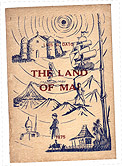|
|
| Baao, Camarines Sur, Philippines | |
|
Baao, Camarines Sur ...the other version The ancient people of this town were Bikolanos who grouped themselves near the lake. Possibly they must have come from Cagraray Cave in Albay, or Bacon, Pilar and Casiguran, Sorsogon, or most probably even from Calanay in Masbate. One will be surprised to know that this statement is being proven today after the excavations made in the Bicol peninsula at Cagraray Cave in Albay, in Bato, Camarines Sur, Bacon, Pilar, and Casiguran all of Sorsogon Province. All the artifacts found in those places attest to the fact that the ancient Bicolanos have their prehistoric culture and civilization. The burial jars, the pottery, and implements used by the ancient people are evidences of this fact1. One has to go to the Museum of the Holy Rosary Minor Seminary at the City of Naga, to see these recent findings- burial jars, pottery, stone and iron implements, and other artifacts found in the above named places. Whatever is known about the history and culture of the town of Baao has been culled from the writings of the Spaniards especially the friars who were assigned to Bicol in the early years of the Spanish regime. Possibly, the communities which we now know as the towns of Baao and Bula were already in existence at the time of the coming of Legazpi in 1571. The pre-Spanish Filipinos, Bicolanos included, used to build their towns and barangays on the banks of the rivers and lakes and near the sea, but there were no writings of the early people of Baao, because it was the policy of the Spaniards to burn such writings in the belief that they were works of the devils and therefore against the tenets of the Christian religion. When the Spaniards arrived, the town of Baao was not yet separated from the town of Bula from which the latter was mentioned among the first municipalities in Camarines founded by the Spaniards in the last year of the 15th century. The first site of the town was in Binanuaanan, Binabaloy and Layoan located at the bank of a lake which was a very marshy lowland. To avoid the unfavorable climate, the site was moved southward to the confluence of Langday and Bay Rivers on which the present barangay of San Francisco stands. But since the site is still low and marshy, the town was moved up to the higher ground where the poblacion of Baao today is located. To the northeast of the town, is the barangay of Agdangan, with a distance of seven kilometers more or less. It is connected by the National Highway to Pili, capital town of Camarines Sur and two other roads to the municipality of Nabua and the City of Iriga. In corroboration of the early accounts of the site of Baao in sitio Binanuaanan, as well as the extensive commercial relations between China and the Philippines in pre-Spanish times, was the findings of porcelain artifacts identified to have been made during the Ming Dynasty (13th century) or 300 years before the arrival of the Spaniards. These artifacts were found by accident in sitio Mawacag in 1975 some 2.5 kilometers distant from sitio Binanuaanan. Recalling the pre-Spanish Filipino custom of burying with the dead their clothing, food, implements, weapons, it is quite possible that these artifacts were buried some distance away from the original site of Binanuaanan.
This also shows that as early as 1706, or earlier, Baao was already an independent parish from Bula, at least 87 years earlier than the date of the ecclesiastical separation of Baao from Bula. There are three theories about the origin of Baao's name. One of them obviously inspired by malice or good natured banter, namely that Baao came from the term "bahaw", attributable to the predilection of the inhabitants to eat left-over rice from a previous meal. The more credible account is that the early site of the town in sitio Binanuaanan at the southern bank of Lake Baao was concave, like the back of a turtle. Equally plausible is the account that in the early days in sitio Binanuaanan, there was an abundance of turtles "ba-o-o" which gave the name of the town. One of the prominent sons of this town who gained national prominence is Msgr. Jorge Imperial Barlin, the first Filipino Bishop who was elevated to the episcopacy on June 29, 1906 in Manila. As a Vicar of Sorsogon he governed the province when Spanish Governor Villamil fled to Manila during the Philippine Revolution. As the only Filipino bishop at that time, he was given the signal honor of delivering the invocation at the inaugural session of the Philippine Assembly on October 16, 1907. Another well-known educator and man of letters is Luis G. Dato whose poetry made him famous. He translated Rizal's Ultimo Adios in Bicol dialect and wrote a Bicol version of the National Anthem . Before his death, the United Poet Laureate International awarded him the "Outstanding Catholic Poet of the Philippines." He also wrote the longest epic - English - The Land of Mai, published by Jaime T. Malanyaon former Superintendent of Schools of Camarines Sur. He also wrote a new English version of the Philippine National Anthem.
Source: Jaime T. Malanyaon, Istorya kan Kabikolan ,AMS Press, 1991 pp. 157-160 |
|
|
|

|